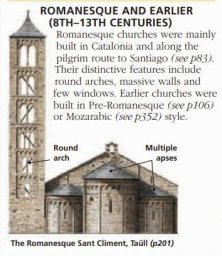Architecture in Spain
Spain has always imported its styles of architecture: Moorish from North Africa, Romanesque and Gothic from France and Renaissance from Italy. Each style, however, was interpreted in a distinctively Spanish way, with sudden and strong contrasts between light and shady areas; façades alternating between austerity and extravagant decoration; and thick walls pierced by few windows to lessen the impact of heat and sunlight. Styles vary from region to region, reflecting the division of Spain before unification. The key design of a central patio surrounded by arcades has been a strong feature of civil buildings since Moorish times.
The 15th-century Casa de Conchas in Salamanca
ROMANESQUE AND EARLIER (8TH–13TH CENTURIES)
Romanesque churches were mainly built in Catalonia and along the pilgrim route to Santiago. Their distinctive features include round arches, massive walls and few windows. Earlier churches were built in Pre-Romanesque or Mozarabic style.
The Romanesque Sant Climent, Taüll
MOORISH (8TH–15TH CENTURIES)
The Moors reserved the most lavish decoration for the interior of buildings, where ornate designs based on geometry, calligraphy and plant motifs were created in azulejos (tiles) or stucco. They made extensive use of the horsehoe arch, a feature inherited from the Visigoths. The greatest surviving works of Moorish architecture are in Southern Spain.
The Salón de Embajadores in the Alhambra has exquisite Moorish decoration
GOTHIC (12TH–16TH CENTURIES)
Gothic was imported from France in the late 12th century. The round arch was replaced by the pointed arch which, because of its greater strength, allowed for higher vaults and taller windows. External buttresses were added to prevent the walls of the nave from leaning outwards. Carved decoration was at its most opulent in the Flamboyant Gothic style of the 15th century. After the fall of Granada, Isabelline, a late Gothic style, developed. Meanwhile, Moorish craftsmen working in reconquered areas created the highly decorative hybrid Christian-Islamic style Mudéjar.
Sculptural decoration above the doorways of León cathedral’s south front depicted biblical stories for the benefit of the largely illiterate populace
The nave of León Cathedral, built in the 13th century, is supported by rib vaulting and is illuminated by the finest display of stained glass in Spain
Gothic arched window
RENAISSANCE (16TH CENTURY)
Around 1500 a new style was introduced to Spain by Italian craftsmen and Spanish artists who had studied in Italy. The Renaissance was a revival of the style of Ancient Rome. It is distinguished by its sense of symmetry and the use of the round arch, and Doric, Ionic and Corinthian columns. Early Spanish Renaissance architecture is known as Plateresque because its fine detail resembles ornate silverwork (platero means silversmith).
The Palacio de las Cadenas in Úbeda has a severely Classical façade
The Hostal de San Marcos in León, one of Spain’s finest Plateresque buildings
BAROQUE (17TH–18TH CENTURIES)
Baroque was driven by a desire for drama and movement. Decoration became extravagant, with exuberant sculpture and twisting columns. Although the excessive Baroque style of Churrigueresque is named after the Churriguera family of architects, it was their successors who were its main exponents.
The ornamentation on the Baroque façade of Valladolid University is concentrated above the doorway
The façade of the Museo de Historia in Madrid
MODERN (LATE 19TH CENTURY ONWARDS)
Modernisme, a Catalan interpretation of Art Nouveau, is seen at its best in Barcelona. Its architects experimented with a highly original language of ornament. In recent decades, Spain has seen an explosion of bold, functionalist architecture in which the form of a building reflects its use and decoration is used sparingly.
Casa Milà, in Barcelona, was built in 1910 by Modernisme’s most famous and best-loved architect, Antoni Gaudí, who drew much of his inspiration from nature
Torre de Picasso in Madrid
